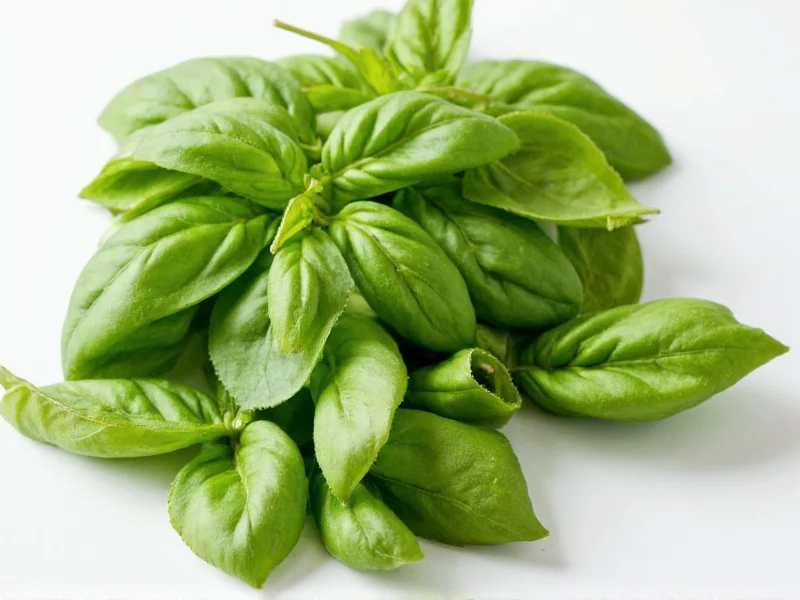When working with herbs in the kitchen, understanding proper conversions between dried and fresh varieties is essential for recipe success. Basil, one of the most popular culinary herbs, undergoes significant flavor and potency changes when dried, making accurate substitutions crucial for achieving desired results in your cooking.
Understanding the Flavor Transformation
Fresh basil offers a bright, sweet, and slightly peppery flavor with subtle notes of anise and clove. When basil is dried, its chemical composition changes, concentrating certain compounds while diminishing others. The drying process reduces the herb's moisture content from approximately 92% in fresh basil to about 10% in dried basil, resulting in a more intense but less complex flavor profile.
Dried basil develops earthier, more muted notes compared to its fresh counterpart, with diminished volatile oils that give fresh basil its characteristic aroma. This transformation explains why simply using equal amounts of dried basil in place of fresh will result in an overpowering, sometimes bitter flavor in your dishes.
Precise Conversion Guidelines for Cooking
Mastering the dried basil to fresh conversion ratio ensures your recipes maintain their intended flavor balance. The standard culinary conversion follows these measurements:
| Dried Basil | Fresh Basil Equivalent | Common Recipe Measurement |
|---|---|---|
| ¼ teaspoon | ¾ teaspoon | Small side dishes |
| ½ teaspoon | 1½ teaspoons | Sauces for 2-4 servings |
| 1 teaspoon | 1 tablespoon | Standard recipe measurement |
| 1 tablespoon | 3 tablespoons (¼ cup) | Larger recipes or batches |
| 2 tablespoons | 6 tablespoons (⅓ cup) | Family-sized meals |
When to Use Dried Basil vs. Fresh Basil
Certain cooking applications benefit from one form of basil over the other. Understanding these distinctions helps you make better ingredient choices for optimal flavor development:
Best Uses for Dried Basil
- Long-simmered dishes: Soups, stews, and tomato sauces benefit from dried basil's concentrated flavor that withstands extended cooking times
- Dry rubs and spice blends: Dried basil integrates better with other dry ingredients
- Baked goods: Bread, focaccia, and savory pastries where fresh herbs would release too much moisture
- Winter cooking: When fresh basil isn't in season or readily available
Best Uses for Fresh Basil
- Raw applications: Pesto, salads, and garnishes where the bright flavor shines
- Quick-cooking dishes: Stir-fries, omelets, and pasta dishes added at the end of cooking
- Cold preparations: Caprese salad, cold soups, and summer dishes
- Delicate sauces: Where the fresh herb's volatile oils enhance aroma
Practical Substitution Tips for Home Cooks
When substituting dried basil for fresh in recipes, consider these professional cooking techniques:
- Rehydrate dried basil by sprinkling it with a few drops of warm water before adding to recipes. Let it sit for 5-10 minutes to restore some moisture content, which helps distribute flavor more evenly
- Add dried basil earlier in the cooking process than fresh basil to allow time for its flavors to develop and integrate with other ingredients
- Taste and adjust after the initial conversion ratio, as basil potency can vary based on brand, age, and storage conditions
- Consider the dish's cooking time—for recipes with less than 15 minutes of cooking, reduce the dried basil amount by 25% to prevent overpowering flavors
- Combine forms strategically—use dried basil during cooking and finish with fresh for layered flavor complexity
Storage Methods to Maximize Flavor
Proper storage significantly impacts the potency of both dried and fresh basil, affecting your conversion calculations:
Fresh Basil Storage
Treat fresh basil like cut flowers: trim stems, place in a glass with 1-2 inches of water, cover loosely with a plastic bag, and refrigerate. Change water every two days. Properly stored, fresh basil maintains peak flavor for 7-10 days. For longer storage, chop basil, mix with olive oil, and freeze in ice cube trays—a method that preserves 80-90% of its flavor compounds.
Dried Basil Storage
Store dried basil in an airtight container away from light, heat, and moisture. Properly stored, dried basil maintains optimal potency for 1-2 years. After this period, you may need to increase the amount by 25-50% to achieve the same flavor intensity. Test older dried basil by rubbing a small amount between your fingers—if the aroma is weak, it's time to replace it.
Common Substitution Mistakes to Avoid
Many home cooks make these errors when converting between dried and fresh basil:
- Using equal measurements: Treating dried and fresh basil as interchangeable without adjusting quantities
- Adding dried basil too late: Not giving dried herbs enough time to rehydrate and release flavors during cooking
- Overcompensating for dried basil: Using too much dried basil when fresh isn't available, resulting in bitter, overpowering flavors
- Ignoring recipe timing: Not adjusting when to add the herb based on its form
- Using degraded product: Not accounting for reduced potency in older dried basil or wilted fresh basil
Recipe Conversion Examples
Seeing conversions in practical applications helps solidify understanding. Here are real-world examples:
Tomato Basil Sauce
Original recipe calls for ¼ cup fresh basil, chopped. For dried basil substitution: ¼ cup fresh = 1¼ tablespoons dried. However, since this is a long-simmered sauce, use 1 tablespoon dried basil added at the beginning of cooking, then finish with 1-2 fresh leaves if available.
Pesto
Traditional pesto requires fresh basil for its characteristic bright flavor. If substituting dried basil, use 1½ tablespoons dried basil plus 1 tablespoon lemon juice to mimic some freshness. Note that the texture and flavor profile will differ significantly from authentic pesto.
Caprese Salad
This dish absolutely requires fresh basil—dried basil cannot substitute effectively in raw applications. The visual appeal and delicate flavor profile depend on fresh leaves.











 浙公网安备
33010002000092号
浙公网安备
33010002000092号 浙B2-20120091-4
浙B2-20120091-4